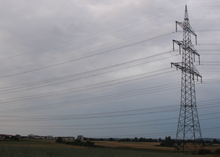
An aerial cable or air cable is an insulated cable usually containing all conductors required for an electrical distribution system (typically using aerial bundled cables) or a telecommunication line, which is suspended between utility poles or electricity pylons. As aerial cables are completely insulated there is no danger of electric shock when touching them and there is no requirement for mounting them with insulators on pylons and poles. A further advantage is they require less right of way than overhead lines for the same reason. They can be designed as shielded cables for telecommunication purposes. If the cable falls, it may still operate if its insulation is not damaged.
As aerial cables are installed on pylons or poles, they may be cheaper to install than underground cables, as no work for digging is required, which can be very expensive in rocky areas.
Use
Aerial cables are mostly used for telecommunication systems or for power transmissions with voltages below 1000 volts. Aerial cable for voltages up to 69,000 volts has also been built, for the supply of farms, waterworks, transmitters and other facilities outside of urban areas. Aerial cables are not often used in transmission circuits because of the difficulty in insulating such high voltage wire. Because of the proven reliability benefits of insulated aerial cables over traditional air-insulated wire, the Electric Power Institute has been working with utility companies to develop better insulating materials. In 1996 they were able to successfully convert one lower-voltage transmission circuit to insulated cable.
Aerial cables are usually freely hanging. However the former German power company EVS used for their internal communication network communication cables that were fixed like a garland on the ground conductor or on an auxiliary rope. Although the fact, that EVS is today part of EnBW and that beginning at the end of the 1980s replacement of such cables by freely hanging cables have started, there are still today many of these installations in use.

See also
References
- Kuhlenengel, M.; Landinger, C.; Bello, S.; Grenier, G.; Psilopoulos, K. (1999). "Development and installation of a 69 kV aerial cable system". 1999 IEEE Transmission and Distribution Conference (Cat. No. 99CH36333). pp. 836–841 vol.2. doi:10.1109/TDC.1999.756159. ISBN 0-7803-5515-6. S2CID 110650132.